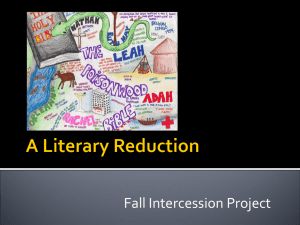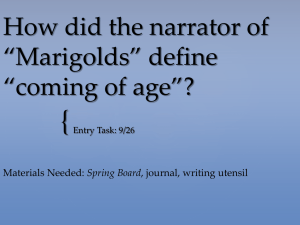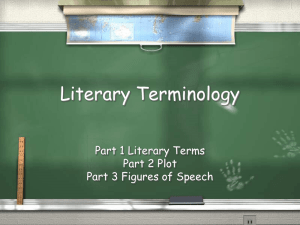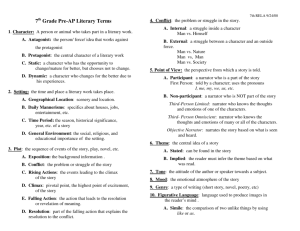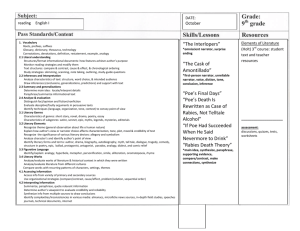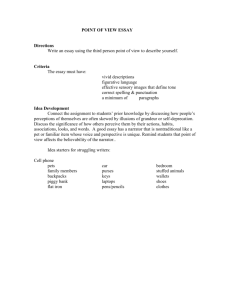STUDY GUIDE ENGLISH I
advertisement
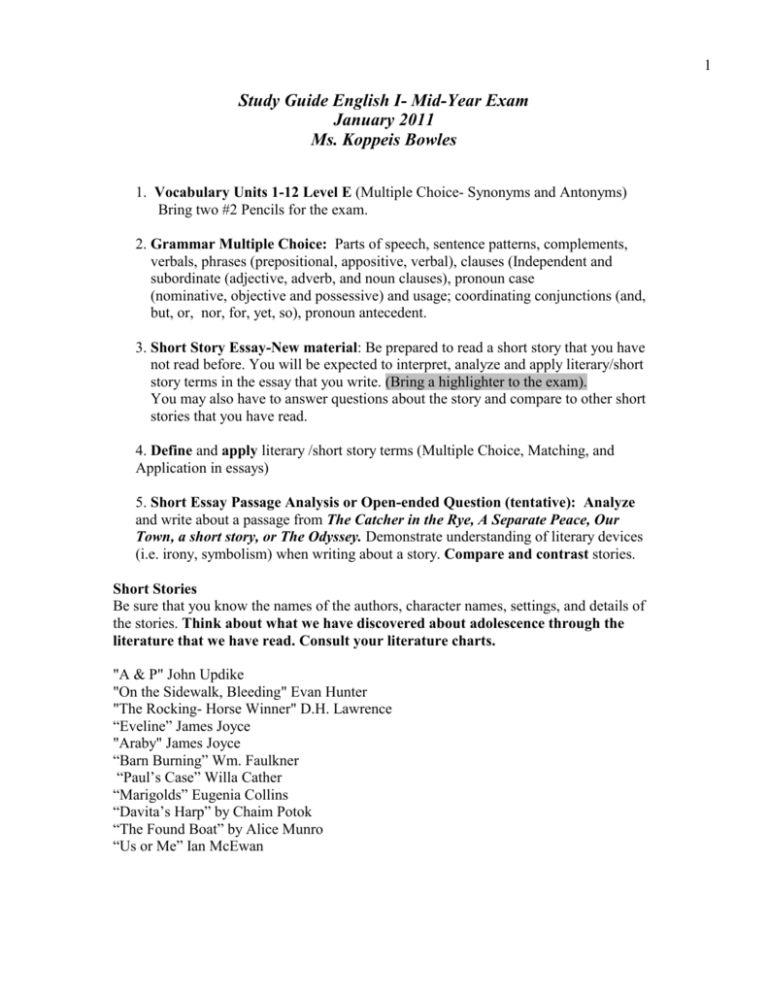
1 Study Guide English I- Mid-Year Exam January 2011 Ms. Koppeis Bowles 1. Vocabulary Units 1-12 Level E (Multiple Choice- Synonyms and Antonyms) Bring two #2 Pencils for the exam. 2. Grammar Multiple Choice: Parts of speech, sentence patterns, complements, verbals, phrases (prepositional, appositive, verbal), clauses (Independent and subordinate (adjective, adverb, and noun clauses), pronoun case (nominative, objective and possessive) and usage; coordinating conjunctions (and, but, or, nor, for, yet, so), pronoun antecedent. 3. Short Story Essay-New material: Be prepared to read a short story that you have not read before. You will be expected to interpret, analyze and apply literary/short story terms in the essay that you write. (Bring a highlighter to the exam). You may also have to answer questions about the story and compare to other short stories that you have read. 4. Define and apply literary /short story terms (Multiple Choice, Matching, and Application in essays) 5. Short Essay Passage Analysis or Open-ended Question (tentative): Analyze and write about a passage from The Catcher in the Rye, A Separate Peace, Our Town, a short story, or The Odyssey. Demonstrate understanding of literary devices (i.e. irony, symbolism) when writing about a story. Compare and contrast stories. Short Stories Be sure that you know the names of the authors, character names, settings, and details of the stories. Think about what we have discovered about adolescence through the literature that we have read. Consult your literature charts. "A & P" John Updike "On the Sidewalk, Bleeding" Evan Hunter "The Rocking- Horse Winner" D.H. Lawrence “Eveline” James Joyce "Araby" James Joyce “Barn Burning” Wm. Faulkner “Paul’s Case” Willa Cather “Marigolds” Eugenia Collins “Davita’s Harp” by Chaim Potok “The Found Boat” by Alice Munro “Us or Me” Ian McEwan 2 Drama Our Town and Drama Terms Novels The Catcher in the Rye by J.D. Salinger A Separate Peace by John Knowles Essential questions: How can our perceptions cloud our perspective of the world? What is the inevitable conflict of growing up as we see it in The Catcher in the Rye and A Separate Peace? Is pain necessary for personal growth? What does the transition from adolescence to adulthood require? Epic Poem- The Odyssey Elements of the epic poem, basic story line, values of the Greeks, mortals and immortals, characters. Literature and Literary Terms Application- Demonstrate reading comprehension; interpretation and application of terms on new material. character plot setting theme conflict dialect diction allusion foreshadowing tone point of view mood style structure the “punch line” of the story flat (static) character round (dynamic) character epic epiphany (moment of realization, insight, discovery, revelation) irony metaphor simile protagonist/ antagonist resolution simile symbol in medias res epithet climax imagery initial incident, rising action, climax, resolution personification exposition subtext Writing Skills- Essay on a theme, literary passage or how a literary term is used in a story. Analytical Skills (Analyzing a literary passage) Drawing inferences Writing and critical thinking skills: focus, organization, clarity, accuracy, depth, paragraph and topic development, transitions, logic, ability to demonstrate knowledge and comprehension of a piece of literature; show insight and depth of understanding; analyze a piece of literature using textual support, smoothly integrate quotations to support assertions. 3 Knowledge of the basic essay structure: Introduction—clear focus and thesis statement Body- at least 3 supporting examples/details in each paragraph Conclusion- Evaluate, draw inferences/conclusions based on the facts and details that you have provided in the body of your essay. Do NOT just restate what you said in your introduction! Be able to write 3-5 paragraph responses in an organized and coherent manner with a clear thesis statement that dictates the content of your piece of writing. Use supporting examples, details, quotations from the texts and reasons as evidence. Focus- Is your thesis statement clear? Does it dictate the focus of your paper? Paragraphing and paragraph development Logic in connections and transitions between paragraphs and within paragraphs Do not forget to quote titles of short stories and underline titles of novels. Evaluating information; creative thinking; depth of thought Properly document. Understanding Character—What a character says, does, thinks, what is said about a character, how a character feels, how a character acts, what influences a character—(age, background, gender, environment, time period, culture, beliefs, family, friends, personality, inner nature) What motivates the character to act as he/she does? (action) What are the character's personality traits? How does the character feel? What are the thoughts of the character? What does the character say in the story? How is the character described? (narration, exposition) What do other characters say about the character? Is what they say valid or not? Why or why not? (dialogue) What age is the character, and how might it influence the character's actions? (exposition) What is the character's background, and how does it influence the character? What other influences on the character can you identify? Round (dynamic, changes) or Flat (static, remains the same) 4 Recognizing aspects of the setting Time Place- Geographical and emotional Historical period Season, weather Immediate surroundings Mood or atmosphere Understanding Conflict What is the complication, problem, dilemma or situation that sets the story into motion? What are the internal and external conflicts in the story? Human vs. nature Human vs. self Human vs. society Human vs. other humans Human vs. machine Human vs. the supernatural Knowing the Literary Point of View-Who is telling the story? Participant- 1st person (I) narrator (character is part of the story) Narrator as non-participant in the story- (3rd Person He, She) 3rd person narrator that is an objective person, not seeing into any of the characters; narrator who is just telling the story 3rd person narrator limited omniscient (he, she) (narrator is outside of the story)-can see into one major or minor character 3rd person omniscient (all-knowing) narrator (narrator is outside the story, and able to get into the thoughts and minds of the characters) Approaching the short story: Asking relevant and significant questions, and writing them down Thinking about a story Rereading the story Taking notes in the form of significant quotations, questions and ideas Knowing the details of the story—Plot, characters, setting, point of view, literary devices Identifying the theme(s) or point that the writer is trying to get across Using a dictionary Recognizing the tone of the story Being able to describe the style of the story Looking carefully at the title of the story 5 Rereading the beginning and the end of the story, particularly the last line or paragraph for the “punch line.”
